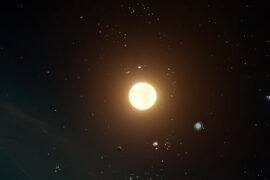There are two main categories of objects most people want to look at when they are thinking about buying a new telescope. Objects in our Solar system (The Moon, Planets, Comets), and objects beyond the Solar System (Galaxies, Nebulas, Star Clusters, Constellations).
While most telescopes have the ability to capture all those objects, some do perform better at certain tasks, so, if your main target is going to be galaxies and deep-sky objects, there are telescopes that will make the experience much better.
I have detailed the selection process and what you should be looking out for in a telescope to observe galaxies below, but if you are in a hurry, here’s our top pick.
Best pick: Celestron StarSense LT 114AZ
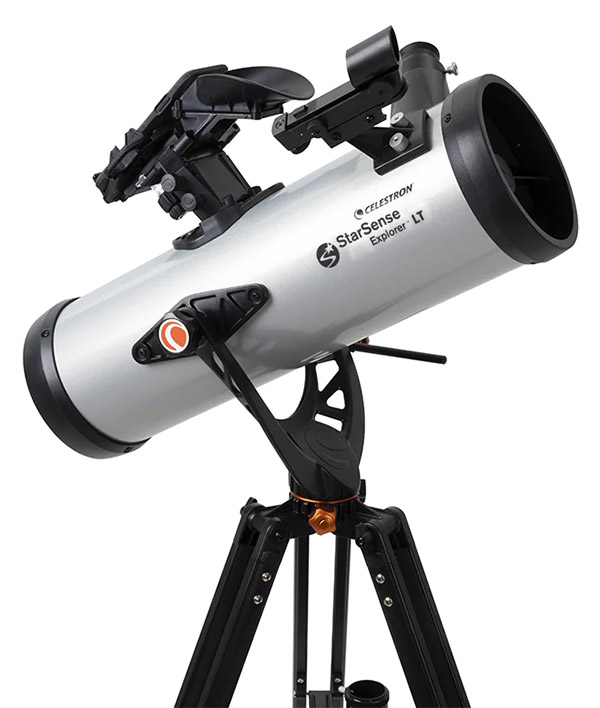
The StarSense technology makes it easy for a beginner to learn. It takes out many of the complications of getting started with stargazing.
Observing galaxies, nebulae, star clusters, and all the other deep-space objects is a beautiful experience. But the part no one talks about when they are introducing you to the stargazing hobby is that finding all those objects is hard and time-consuming.
It is possible to spend 10-30 minutes trying to figure out where that galaxy that you are trying to view is, especially if it is not near any prominent star formation that you could use as a reference point. This part can be frustrating for a beginner who just wants to enjoy his or her brand new device.
There’s a solution, though. The StarSense line of telescopes does a lot to fix this issue. It is a regular telescope but it comes with a smartphone holder. Attach your phone, and start the included app. You will be asked to follow some instructions to align the telescope. The app then will map out the sky for your location and date and show you on the screen what is it exactly you are looking at. You can also search in the database for a specific galaxy, star, or other object and the app will guide you to where you need to point the mirror so you can see it.
It is super useful for finding everything you want to see and saves lots of time and peace of mind.
The aperture of this model is 114mm which isn’t too powerful but it is good enough to view any objects of a magnitude of 13.2 and below which includes dozens of galaxies including Andromeda (3.4 magnitude), the Whirpool Galaxy (5.1), the Sombrero Galaxy (8.9) and many others.
The optic quality is on par with what you’d expect out of any Celestron telescope. It is in the good to great category and pretty much free of any chromatic or spherical errors.
There is a larger 130mm version of this that comes with a slightly better mount but the jump in price is a bit steep for my taste. If you don’t mind and you have the budget for it, it is a great choice as well that will get you more detailed images.
If you’d like to skip directly to the rest of the recommendations, click the button below
Best magnification and aperture to see galaxies
Aperture
The best aperture to view galaxies is the biggest you can get. The aperture is the most important specification for your telescope because it determines the amount of light the lens is able to capture. More light equals more information which results in an image with more colors, details, and sharpness.
Galaxies are no different than other objects in this regard. The aperture should be your first consideration when it comes to a telescope and you want to get the biggest one that your budget and viewing conditions allow for. For example, if you plan to buy a telescope for camping you will have to consider things like weight and size, but within that pool of options, the ones with the larger aperture should be your top choices.
If you need more information about aperture we have a whole article explaining what it is, but in short, it is simply how big the front lens of the telescope is.
Magnification
When it comes to galaxies, there is a wide variety of sizes, brightness, and types. It’s not possible to group them all in such a way that a single magnification is the definitive “best” answer to observe them all and get perfect results every time. There’s a bit of trial and error.
That being said, for most home telescopes, the optimal magnification to view most galaxies and deep sky objects is going to be between 80x and 150x depending on the specific object that you are looking at and the specifications of the telescope.
Going beyond that to a magnification of 200x-300x is usually not just unnecessary, but it can be detrimental in most situations.
The magnification is the result of diving the telescope’s focal length by the eyepiece’s focal length.
The good news is that there are multiple ways to increase and decrease the magnification you get out of a telescope because of two reasons:
- The focal length of a telescope can be increased or decreased using certain accessories
- You can change eyepieces to also get more or less power
So, don’t worry too much about magnification at this point because you can increase your options later through reasonably priced accessories like eyepieces and Barlow lenses.
However, in that formula, there’s a number that does matter and that can significantly improve your viewing experience when it comes to seeing galaxies, and that’s the telescope’s focal length, so let’s talk about that.
Focal length to view galaxies
After the aperture, the characteristic that matters the most in a telescope to optimize for certain types of objects is focal length. We have gone into depth about this in our article about focal length, but to summarize, long focal lengths are better for planetary viewing, and short focal lengths are better for deep-sky objects.
If you are a complete beginner, the focal length of a telescope is the distance the light travels inside the telescope’s tube in order to reach the exit point or focuser.
The telescope designs that tend to have shorter focal lengths are refractors, Newtonians, and some Dobsonians so our recommendations below will focus mostly on those.
There are two reasons why a short focal length is recommended for galaxies and DSOs.
First, due to the lower obstruction, these telescopes tend to show brighter images with slightly better colors. Both of these features can make a huge difference when it comes to the spectacularity of the images you’ll see.
Second, the shorter the focal length of the telescope, the longer the field of view it has. A large field of view allows you to see larger objects (like nebulas and galaxies) more comfortably and without leaving out parts of them.
Best galaxies you can expect to see with a telescope
Here’s a small list of the targets that you can expect to reach with a home or enthusiast-grade telescope. There are millions of galaxies in the observable universe and from your backyard, you’ll be able to observe a few hundred of these.
Remember that sky conditions and location is important. You will always get better results and access to more deep sky objects with clear skies and from a place with low light pollution.
Andromeda
Also known as M31, Andromeda is the closest galaxy to our own. It’s located “only” 2.5 million light-years away from Earth.
It is a classic spiral, disc-shaped galaxy. so it’s a perfect introduction to what a galaxy is and what they look like. It has a mass and size very similar to the Milky Way.
It is located in the same direction as the Andromeda constellation, from which it gets its name.
The Whirpool Galaxy
Also known as M51. It is located in the direction of the small constellation of Canes Venatici which is formed by only two stars.
It’s located 28 million light-years away and has a diameter of 76,000 light-years.
It has an apparent magnitude of 8.4 so it’s no problem to observe it even for a 70mm telescope.
The Sombrero Galaxy
One of the most peculiar galaxies that can be seen with a telescope. It gets its name because it has a dark band in the middle that kind of makes it look like a sombrero.
It is also known as M104 and it can be found in the direction of the Virgo constellation.
The Pinwheel Galaxy
The Pinwheel galaxy is positioned in such a way that it seems to be “facing” us. It has a wide variety of colors and its arms shaped like a spiral can be perfectly appreciated. This makes it one of the best targets to get started with if you want to get into astrophotography.
It can be found in the direction of the Ursa Major constellation.
What galaxies can be seen from a telescope
In order to figure out which galaxies a telescope will be able to observe under normal conditions, you need to know its limiting magnitude.
The magnitude is the brightness of an object in the sky as seen from Earth. The limiting magnitude of a telescope is simply the maximum magnitude the device can reach. So if you have a telescope with a limiting magnitude of 14, anything below that should be visible.
There is a formula to calculate the limiting magnitude of a telescope, but the easiest way is to simply use a calculator like this to do so. You will need to know the telescope’s aperture and type. For power use 100 or 120 and leave the rest of the setting with the default values unless you have enough experience to know what each of them means.
Here’s a list of the limiting magnitudes for some of the most common deep sky objects. We have also saved you time and already listed the approximate limiting magnitude for our telescope recommendations below.
Remember that a lower magnitude means a brighter object.
| DSO | Magnitude |
|---|---|
| Large Magellanic Cloud | 0.13 |
| Small Magellanic Cloud | 1.87 |
| Andromeda Galaxy | 3.4 |
| Beehive Cluster | 4 |
| Lagoon Nebula | 5 |
| Triangulum Galaxy | 5.7 |
| Hercules Cluster | 5.9 |
| Saggitarius Cluster | 6.5 |
| Centaurus A Galaxy | 6.84 |
| Bode’s Galaxy | 6.9 |
| Sculptor Galaxy | 7.2 |
| Dumbbell Nebula | 7.5 |
| Whirpool Galaxy | 8 |
| Crab Nebula | 8.4 |
| Ring Nebula | 9.5 |
Best telescopes for viewing galaxies
Best mid-range: Orion SpaceProbe 130ST
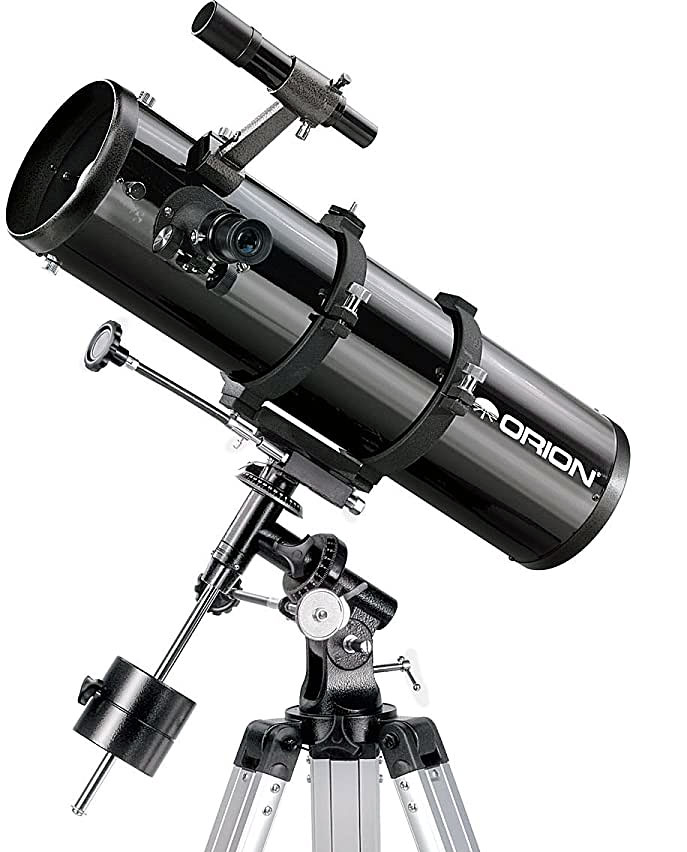
| Model | Orion SpaceProbe 130ST |
| Brand | Orion |
| Type | Newtonian / Reflector |
| Aperture | 130mm |
| Focal length | 650mm |
| Limiting magnitude | 13.2 |
| Max useful magnification | 255x |
| Price |
We have recommended this telescope multiple times now because it really is one of the best all-around reflector devices out there.
The Spaceprobe 130ST has an aperture of 130mm (5.1 inches), which hits the exact sweet spot between a generous aperture, a reasonable price, and a weight/size that can still be considered good enough to take it on a trip.
As mentioned in the sections above, the fact that it is a Newtonian, limits its focal length to the size of the tube, keeping it on the lower side which makes it a really good fit for deep-sky viewing.
The included Equatorial mount is important because even though it has a steeper learning curve for a beginner, it will allow you to grow with it, so you will not feel like the telescope is limiting you at any point as you learn more about stargazing.
The included eyepieces are two Sirius Plossl ones of 10mm and 25mm. These are high-quality eyepieces that will last you forever and that you could even inherit to your next telescope if at some point you decide to upgrade.
If there’s one thing that we can criticize a little bit about Orion is that they don’t tend to include Barlow lenses or smartphone adapters while for other brands this has become the norm. This isn’t a big deal since those are generally cheap, but you will need to get them separately.
While this is not a professional ultra high-end telescope, it’s quite good if you want to get started with astrophotography either using a DSLR or simply a smartphone camera.
In conclusion, the Spaceprobe 130ST is so versatile that it is a great fit for almost anyone. You can’t go wrong with it, especially if your main objective is viewing galaxies.
Alternative: Some popular telescopes have had stock issues for the last few years. If the Spaceprobe 130ST isn’t in stock, the Celestron Astromaster 130EQ is a solid option.
Budget pick: Solomark 114 AZ
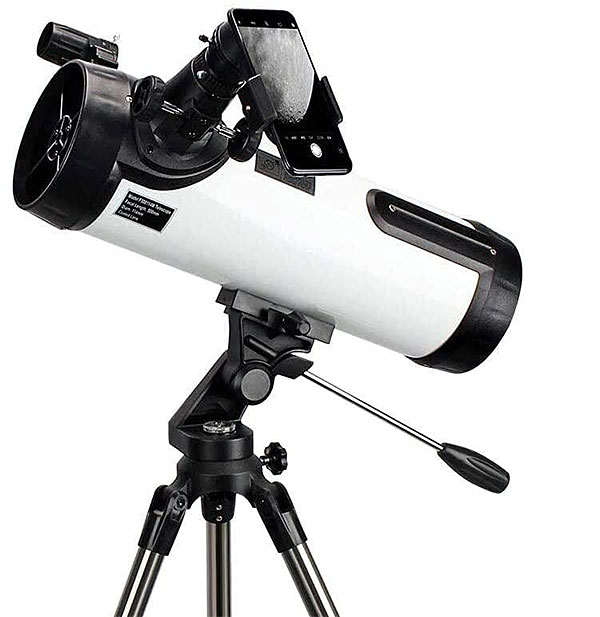
| Model | Solomark 114AZ |
| Brand | Solomark |
| Type | Newtonian / Reflector |
| Aperture | 114mm |
| Focal length | 500mm |
| Limiting magnitude | 12.8 |
| Max useful magnification | 225x |
| Price |
Solomark is an up-and-coming brand that makes telescopes for the amateur astronomer market. We have reviewed a few of their telescopes in the past and have been surprised by the quality of the optics in their devices at such a reasonable price.
The 114AZ is their entry-level Newtonian and it performs on par with what we’ve seen out of the brand in the past.
This telescope is a classic reflector with a small tube that puts its focal length at a good level for deep sky observing. It also has the secondary effect of keeping the scope light and small enough to be portable if you want to take it on a trip.
To keep such a good price, the 114AZ does make some small sacrifices, but they make them in all the right parts because they are things that you can upgrade later on if necessary. For example, it comes with an Alt-Azimuth mount instead of an EQ mount like some comparable telescopes. This makes it easier to use but has the trade-off that as you learn more, you might find it limiting in the future.
It also comes with two Kellner eyepieces out of the box, a 10mm and a 20mm. These are perfectly reasonable eyepieces for beginners, but you will eventually want to replace them with more sophisticated ones, like Plossls.
On the other hand, Solomark definitely did not cut any corners when it comes to optics. The lenses are very high quality and the images are bright and sharp. So, the choices they made to keep the price down are the correct ones.
It also comes with a 1.5x Barlow lens, a moon filter, and a smartphone adapter which are always welcome additions.
Alternative: A slightly better telescope that might be worth considering if you can find it on sale or at a similar price is the Celestron Astromaster 114EQ.
High-end pick: Celestron Advanced VX8
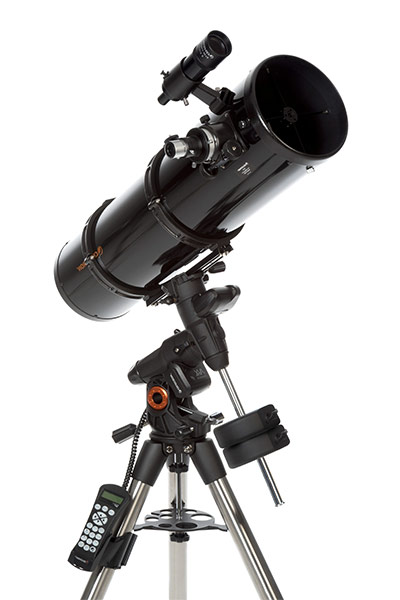
| Model | Celestron Advanced VX8 |
| Brand | Celestron |
| Type | Newtonian / Reflector |
| Aperture | 200mm |
| Focal length | 1000mm |
| Limiting magnitude | 14.2 |
| Max useful magnification | 400x |
| Price |
If you are looking for a powerhouse and budget is not much of an issue. You are REALLY going to enjoy this telescope.
The Advanced VX 8 is the biggest reflector made by Celestron, one of the most trustable brands when it comes to telescopes.
The specifications are perfect for galaxy viewing. It has an aperture of 200mm (8 inches) and a focal length of 1000mm, resulting in an excellent focal ratio of f/4.9 which is exactly what you want for deep sky watching.
Due to the large aperture, the Advanced VX 8 is much heavier than the other recommended telescopes, making it less practical for travel. It is also harder to set up, so take that into consideration if kids are going to use it because they will need the help of an adult.
The included EQ mount is made of stainless steel instead of aluminum to handle the extra weight. It is robust and the tube always feels secure, but if you want to add an extra layer of safety, adding vibration pads won’t hurt.
The accessories included are also of the highest quality which is what you would expect for the price.
First, it comes with a Crayford focuser that allows you to use both 1.25″ and 2″ eyepieces. This type of focuser by itself costs quite some money so it’s always nice to have it come pre-packed.
The included eyepieces are 10mm and 25mm Sirius Plossls of 1.25″. Standard sizes for a reflector. The only thing it is missing is a Barlow lens so you will probably want to grab one separately (here are some recommendations).
It’s hard to find something wrong with this telescope beside the price. If you can afford it, it is definitely worth it.






